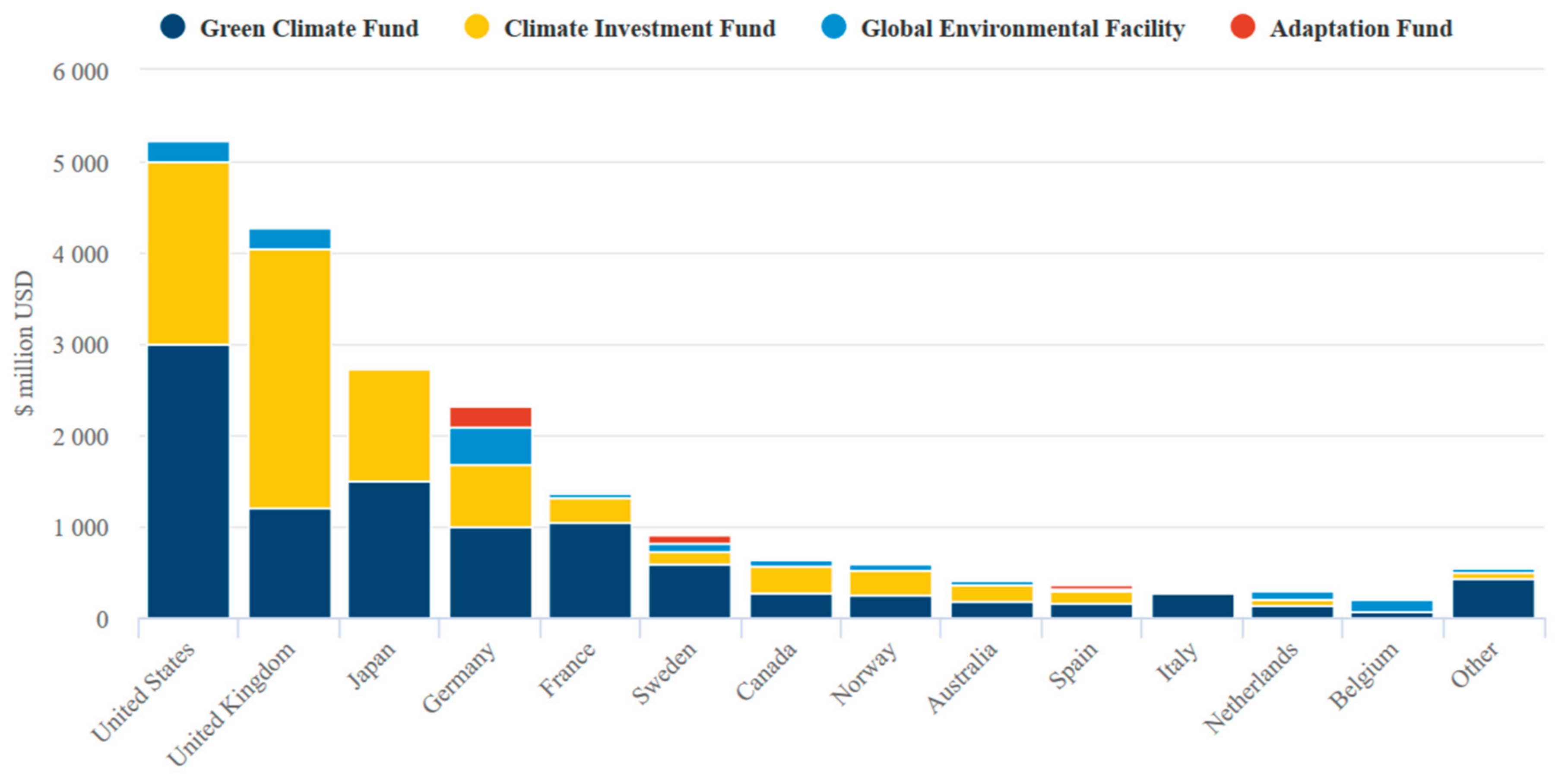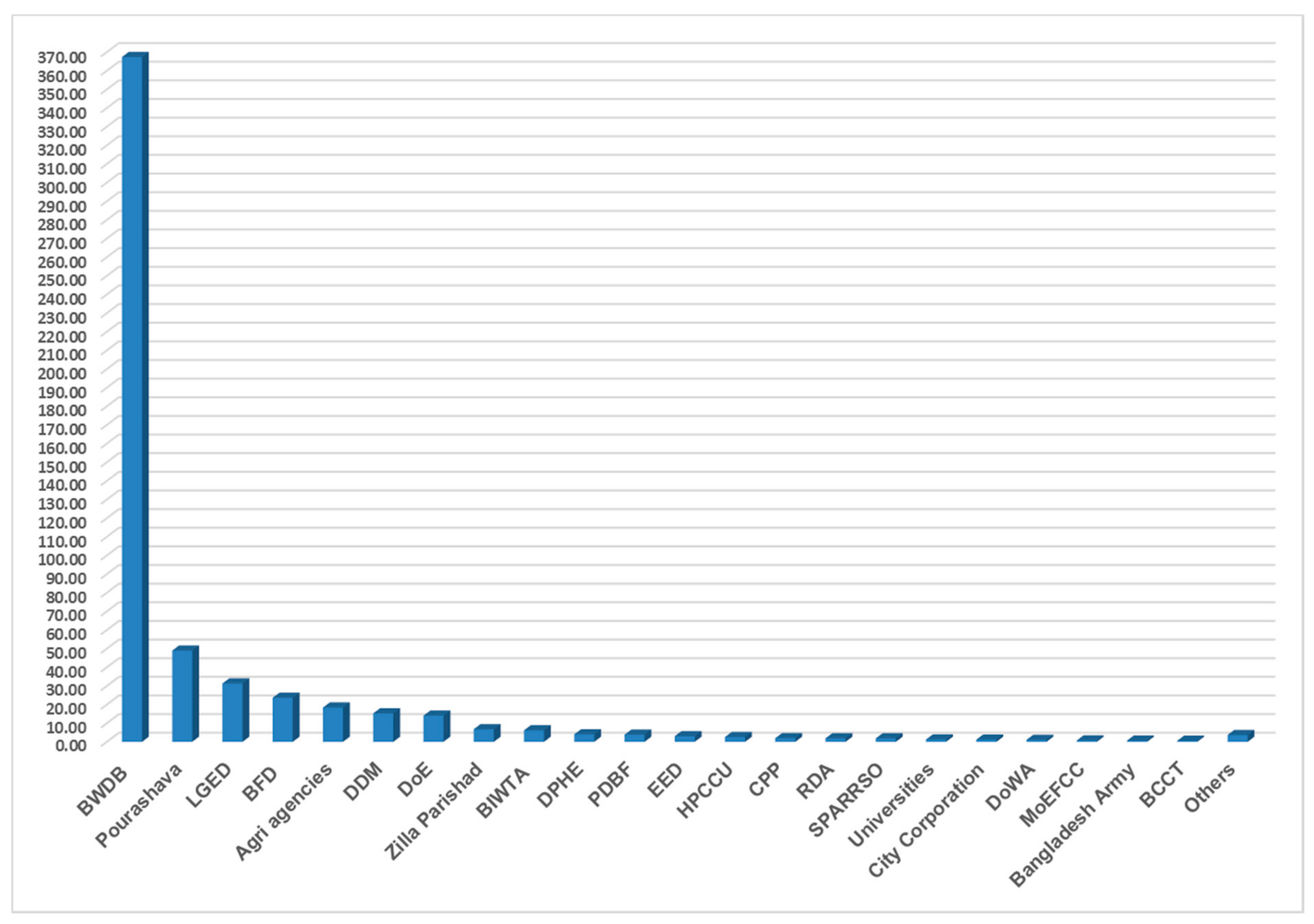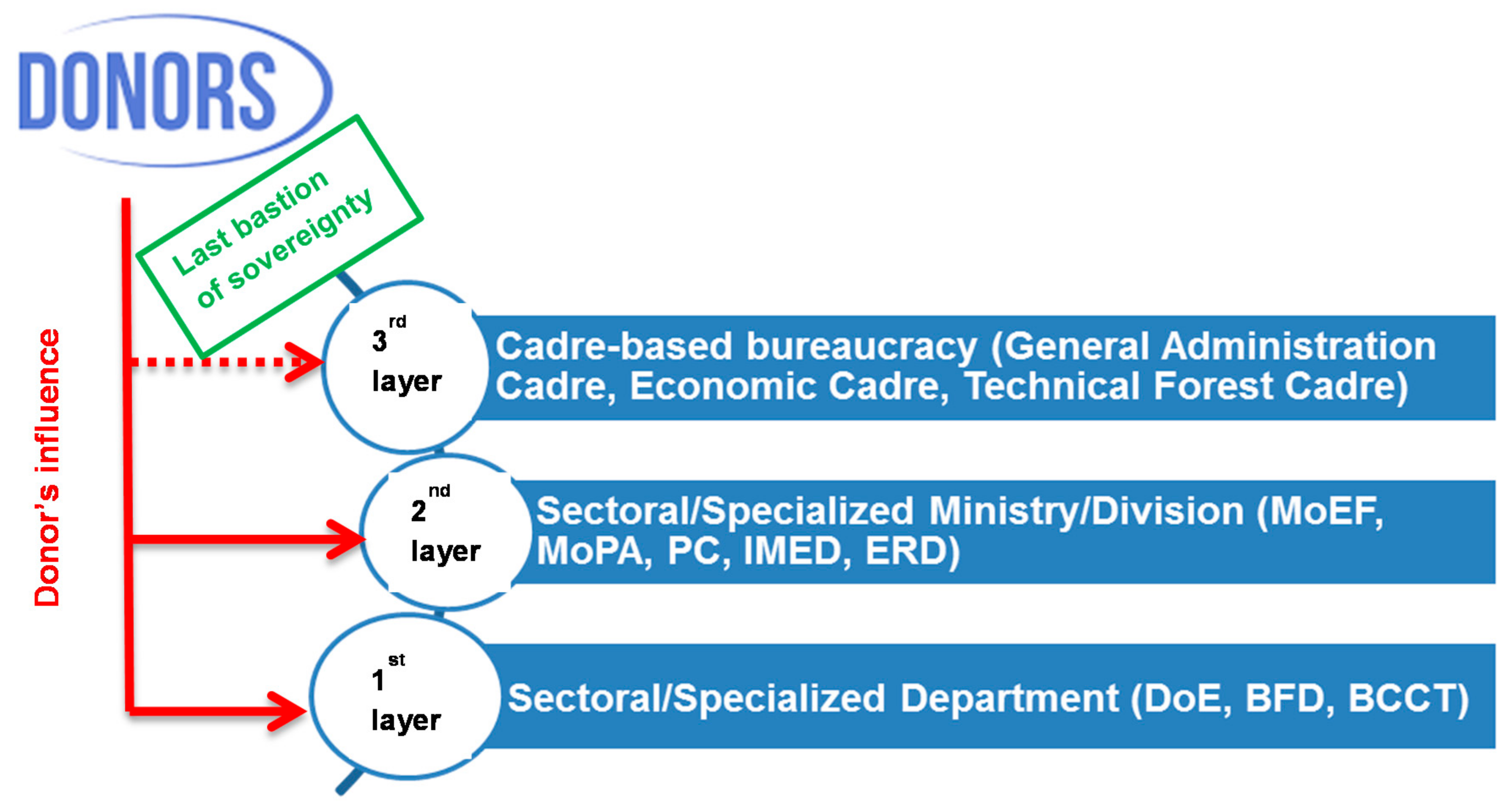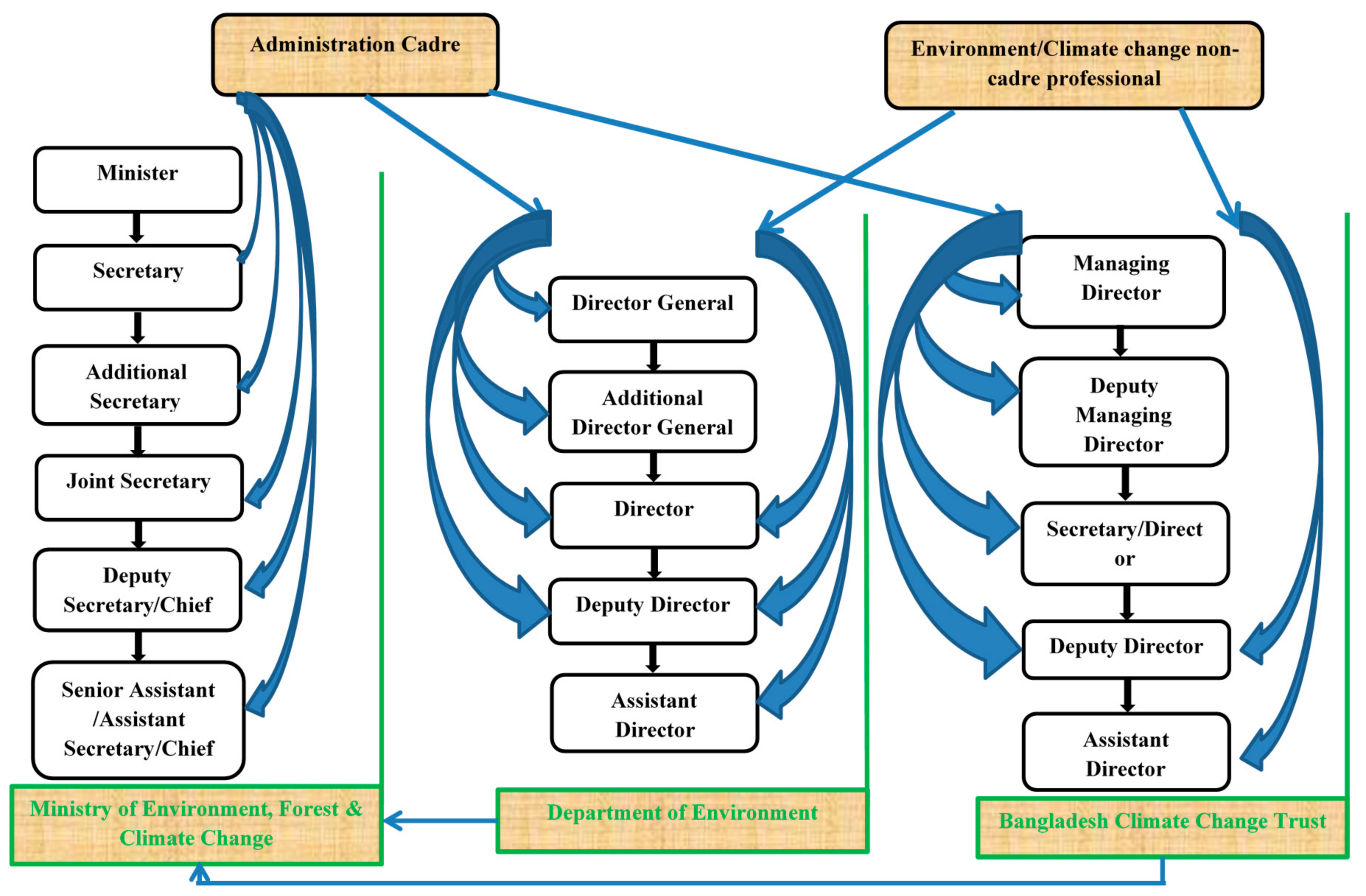Implications of Development Cooperation and State Bureaucracy on Climate Change Adaptation Policy in Bangladesh
Abstract
1. Introduction
2. Country Context: Climate Adaptation Funding Policy in Bangladesh
3. State Administrative Setup of the Climate Change Adaptation Regime in Bangladesh
4. Theoretical Framework
4.1. International Development Cooperation in Climate Adaptation Policy
4.2. State Administrative Traditions and Bureaucratic Politics
5. Materials and Methods
- funding sources
- an amount of funding provided by each donor and domestic organization
- the lead agencies in project implementation
6. Results
6.1. Domestic and International Climate Adaptation Development Funds in Bangladesh from 2009 to 2017
6.2. Implementation of Climate Adaptation Funds by Sectoral Agencies in Bangladesh
6.3. Do International Climate Adaptation Funds Influence State Administrative Traditions?
7. Development Cooperation, State Bureaucratic Politics, and Its Intrinsic Implications on Climate Adaptation Policy: A Critical Discussion
8. Conclusions
Author Contributions
Funding
Acknowledgments
Conflicts of Interest
Appendix A
Appendix A.1.
Appendix A.2.
Appendix A.3.
Appendix A.4.
Appendix A.5.
References
- Dolšak, N.; Prakash, A. The politics of climate change adaptation. Annu. Rev. Environ. Resour. 2018, 43, 317–341. [Google Scholar] [CrossRef]
- Ayers, J. Resolving the adaptation paradox: Exploring the potential for deliberative adaptation policy-Making in Bangladesh. Glob. Environ. Politics 2011, 11, 62–88. [Google Scholar] [CrossRef]
- Ayers, J.; Huq, S.; Wright, H.; Faisal, A.M.; Hussain, S.T. Mainstreaming climate change adaptation into development in Bangladesh. Clim. Dev. 2014, 6, 293–305. [Google Scholar] [CrossRef]
- Coirolo, C.; Rahman, A. Power and differential climate change vulnerability among extremely poor people in Northwest Bangladesh: Lessons for mainstreaming. Clim. Dev. 2014, 6, 336–344. [Google Scholar] [CrossRef]
- Sherman, M.; Ford, J. Stakeholder engagement in adaptation interventions: An evaluation of projects in developing nations. Clim. Policy 2013, 14, 417–441. [Google Scholar] [CrossRef]
- Vij, S.; Biesbroek, R.; Groot, A.; Termeer, K. Changing climate policy paradigms in Bangladesh and Nepal. Environ. Sci. Policy 2018, 81, 77–85. [Google Scholar] [CrossRef]
- Vij, S.; Moors, E.; Ahmad, B.; Arfanuzzaman, M.; Bhadwal, S.; Biesbroek, R.; Gioli, G.; Groot, A.; Mallick, D.; Regmi, B.; et al. Climate adaptation approaches and key policy characteristics: Cases from South Asia. Environ. Sci. Policy 2017, 78, 58–65. [Google Scholar] [CrossRef]
- Ojha, H.; Cameron, J.; Bhattarai, B. Understanding development through the language of Habermas and Bourdieu: Insights from Nepal’s Leasehold Forestry Programme. Int. Dev. Plan. Rev. 2005, 27, 479–497. [Google Scholar] [CrossRef]
- Doshi, D.; Garschagen, M. Understanding adaptation finance allocation: Which factors enable or constrain vulnerable countries to access funding? Sustainability 2020, 12, 4308. [Google Scholar] [CrossRef]
- Mori, A.; Rahman, S.M.; Uddin, N. Climate financing through the adaptation fund: What determines fund allocation? J. Environ. Dev. 2019, 28, 366–385. [Google Scholar] [CrossRef]
- Michaelowa, K.; Michaelowa, A.; Reinsberg, B.; Shishlov, I. Do Multilateral development bank trust funds allocate climate finance efficiently? Sustainability 2020, 12, 5529. [Google Scholar] [CrossRef]
- Howlett, M. Why are policy innovations rare and so often negative? Blame avoidance and problem denial in climate change policy-making. Glob. Environ. Chang. 2014, 29, 395–403. [Google Scholar] [CrossRef]
- Harris, P.G. Collective action on climate change: The logic of regime failure. Nat. Res. J. 2007, 47, 195–224. [Google Scholar]
- Bryner, G. Failure and opportunity: Environmental groups in US climate change policy. Environ. Politics 2008, 17, 319–336. [Google Scholar] [CrossRef]
- Tosun, J. Environmental monitoring and enforcement in Europe: A Review of empirical research. Environ. Policy Gov. 2012, 22, 437–448. [Google Scholar] [CrossRef]
- Shimshack, J.P. The Economics of environmental monitoring and enforcement. Annu. Rev. Resour. Econ. 2014, 6, 339–360. [Google Scholar] [CrossRef]
- Peters, B.G. The Politics of Bureaucracy; Longman Publishers: New York, NY, USA, 1995. [Google Scholar]
- Peters, B.G. The Politics of Bureaucracy—An Introduction to Comparative Public Administration; Routledge: Oxford, UK, 2010. [Google Scholar]
- Zafarullah, H. Bureaucratic elitism in Bangladesh: The predominance of generalist administrators. Asian J. Political Sci. 2007, 15, 161–173. [Google Scholar] [CrossRef]
- Krott, M. Forest Policy Analysis; Springer Publications: Dordrecht, The Netherlands, 2005. [Google Scholar]
- Painter, M.; Peters, B.G. Introduction: The analysis of administrative traditions. In Tradition and Public Administration; Painter, M., Peters, G., Eds.; Palgrave Macmillan: London, UK, 2010; pp. 3–13. [Google Scholar]
- Jordan, A.; Huitema, D. Innovations in climate policy: The politics of invention, diffusion, and evaluation. Environ. Politics 2014, 23, 715–734. [Google Scholar] [CrossRef]
- Jordan, A.; Huitema, D. Policy innovation in a changing climate: Sources, patterns and effects. Glob. Environ. Chang. 2014, 29, 387–394. [Google Scholar] [CrossRef]
- Jordan, A.J.; Huitema, D.; Hildén, M.; Van Asselt, H.; Rayner, T.J.; Schoenefeld, J.J.; Tosun, J.; Forster, J.; Boasson, E.L. Emergence of polycentric climate governance and its future prospects. Nat. Clim. Chang. 2015, 5, 977–982. [Google Scholar] [CrossRef]
- Bernstein, S.; Cashore, B. Complex global governance and domestic policies: Four pathways of influence. Int. Aff. 2012, 88, 585–604. [Google Scholar] [CrossRef]
- Bernstein, S.; Cashore, B. Examination of the influences of global forest governance arrangements at the domestic level. In Embracing Complexity: Meeting the Challenges of International Forest Governance; IUFRO World Series 28; Rayner, J., Buck, A., Katila, P., Eds.; IUFRO Secretariat: Vienna, Austria, 2010; pp. 111–135. [Google Scholar]
- Rahman, M.S.; Giessen, L. The power of public bureaucracies: Forest related climate change policies in Bangladesh (1992–2014). Clim. Policy 2017, 17, 915–935. [Google Scholar] [CrossRef]
- Rahman, S.; Giessen, L. Formal and informal interests of donors to allocate aid: Spending patterns of USAID, GIZ, and EU Forest Development Policy in Bangladesh. World Dev. 2017, 94, 250–267. [Google Scholar] [CrossRef]
- World Bank. Bangladesh: Building Resilience to Climate Change. Available online: http://www.worldbank.org/en/results/2016/10/07/bangladesh-building-resilience-to-climate-change (accessed on 15 January 2018).
- MoEF. National Adaptation Program of Action-2005; Ministry of Environment and Forests, Government of the People’s Republic of Bangladesh and UNDP: Dhaka, Bangladesh, 2005.
- MoEF. Bangladesh Climate Change Strategy and Action Plan-2009; Ministry of Environment and Forests, Government of the People’s Republic of Bangladesh: Dhaka, Bangladesh, 2009.
- MoEF. Rio+20: Bangladesh National Report on Sustainable Development; Ministry of Environment and Forests, Peoples’ Republic of Bangladesh: Dhaka, Bangladesh, 2012.
- BCCRF. Bangladesh Climate Change Resilience Fund. Available online: https://bccrf-bd.org/ (accessed on 28 January 2016).
- Rahman, M.S.; Giessen, L. Mapping international forest-related issues and main actors’ positions in Bangladesh. Int. For. Rev. 2014, 16, 586–601. [Google Scholar] [CrossRef]
- Huque, A.S. Traditions and bureaucracy in Bangladesh. In Tradition and Public Administration; Palgrave Macmillan: London, UK, 2010; pp. 57–68. [Google Scholar]
- Zafarullah, H. Public administration in Bangladesh: Political and bureaucratic dimensions. In Comparative Bureaucratic Systems; Tummala, K., Ed.; Lexington Books: Lanham, MD, USA, 2003. [Google Scholar]
- Mawdsley, E. The changing geographies of foreign aid and development cooperation: Contributions from gift theory. Trans. Inst. Br. Geogr. 2011, 37, 256–272. [Google Scholar] [CrossRef]
- Degnbol-Martinussen, J.; Engberg-Pedersen, P. Aid: Understanding International Development Cooperation; Zed Books Ltd.: London, UK, 2003. [Google Scholar]
- Klingebiel, S. What Is Development Cooperation? Palgrave Macmillan: London, UK, 2014. [Google Scholar]
- Brian, K. OECD Insights from Aid to Development the Global Fight against Poverty: The Global Fight against Poverty; OECD Publishing: Paris, France, 2012. [Google Scholar]
- Aurenhammer, P. Development Cooperation Policy in Forestry from an Analytical Perspective; Springer Science and Business Media LLC: Berlin/Heidelberg, Germany, 2013. [Google Scholar]
- Rahman, S.; Sadath, N.; Giessen, L. Foreign donors driving policy change in recipient countries: Three decades of development aid towards community-based forest policy in Bangladesh. For. Policy Econ. 2016, 68, 39–53. [Google Scholar] [CrossRef]
- Graham, E.R. Follow the money: How trends in financing are changing governance at international organizations. Glob. Policy 2017, 8, 15–25. [Google Scholar] [CrossRef]
- Acharya, A.; De Lima, A.T.F.; Moore, M. Proliferation and fragmentation: Transactions costs and the value of aid. J. Dev. Stud. 2006, 42, 1–21. [Google Scholar] [CrossRef]
- Zimmermann, F.; Smith, K. More actors, more money, more ideas for international development co-operation. J. Int. Dev. 2011, 23, 722–738. [Google Scholar] [CrossRef]
- Carbonbrief. Mapped: Where Multilateral Climate Funds Spend Their Money. Available online: https://www.carbonbrief.org/mapped-where-multilateral-climate-funds-spend-their-money (accessed on 5 September 2018).
- Reinsberg, B. Fully-automated liberalism? Blockchain technology and international cooperation in an anarchic world. Int. Theory 2020, 1–27. [Google Scholar] [CrossRef]
- Hale, T. All hands on deck: The Paris agreement and non-state climate action. Glob. Environ. Politics 2016, 16, 12–22. [Google Scholar] [CrossRef]
- Brukas, V.; Hjortsø, C. A Power analysis of international assistance to Lithuanian forestry. Scand. J. For. Res. 2004, 19, 166–176. [Google Scholar] [CrossRef]
- Shackleton, C.M.; Pandey, A.K. Positioning non-timber forest products on the development agenda. For. Policy Econ. 2014, 38, 1–7. [Google Scholar] [CrossRef]
- Escobar, A. Encountering Development: The Making and Unmaking of the Third World; Princeton University Press: Princeton, UK, 2011; Volume 1. [Google Scholar]
- Pronk, J.P. Aid as a Catalyst. Dev. Chang. 2001, 32, 611–629. [Google Scholar] [CrossRef]
- Sachs, W. (Ed.) The Development Dictionary: A Guide to Knowledge as Power; Zed Books: London, UK, 1992. [Google Scholar]
- Boyce, J.K. Unpacking aid. Dev. Chang. 2002, 33, 239–246. [Google Scholar] [CrossRef]
- Movuh, M.C.Y.; Schusser, C. Power, the hidden factor in development cooperation. An example of community forestry in Cameroon. Open J. For. 2012, 2, 240–251. [Google Scholar] [CrossRef]
- Tallberg, J. The agenda-shaping powers of the EU Council Presidency. J. Eur. Public Policy 2003, 10, 1–19. [Google Scholar] [CrossRef]
- Öberg, P.; Lundin, M.; Thelander, J. Political power and policy design: Why Are policy alternatives constrained? Policy Stud. J. 2014, 43, 93–114. [Google Scholar] [CrossRef]
- Halligan, J. Civil Service Systems in Anglo-American Countries; Edward Elgar Publishing: Cheltenham, UK, 2004. [Google Scholar]
- Yesilkagit, K. The future of administrative tradition: Tradition as ideas and structure. In Tradition and Public Administration; Palgrave Macmillan: London, UK, 2010; pp. 145–157. [Google Scholar]
- Peters, B.G.; Pierre, J. The Politicization of the Civil Service in Comparative Perspective: A Quest for Control; Routledge: London, UK, 2004. [Google Scholar]
- Peters, B.G. Policy capacity in public administration. Policy Soc. 2015, 34, 219–228. [Google Scholar] [CrossRef]
- Giessen, L.; Krott, M.; Möllmann, T. Increasing representation of states by utilitarian as compared to environmental bureaucracies in international forest and forest–environmental policy negotiations. For. Policy Econ. 2014, 38, 97–104. [Google Scholar] [CrossRef]
- Krott, M. Öffentliche Verwaltung im Umweltschutz: Ergebnisse einer behördenorientierten Policy-Analyse am Beispiel Waldschutz; W. Braumüller: Wien, Austria, 1990. [Google Scholar]
- Giessen, L.; Sarker, P.K.; Rahman, S. International and Domestic Sustainable Forest Management Policies: Distributive Effects on Power among State Agencies in Bangladesh. Sustainability 2016, 8, 335. [Google Scholar] [CrossRef]
- Khan, F.A.; Rahman, S.; Giessen, L. Mangrove forest policy and management: Prevailing policy issues, actors’ public claims and informal interests in the Sundarbans of Bangladesh. Ocean Coast. Manag. 2020, 186, 105090. [Google Scholar] [CrossRef]
- Krott, M.; Bader, A.; Schusser, C.; Devkota, R.; Maryudi, A.; Giessen, L.; Aurenhammer, H. Actor-centred power: The driving force in decentralised community based forest governance. For. Policy Econ. 2014, 49, 34–42. [Google Scholar] [CrossRef]
- Niskanen, W. Bureaucracy and Representative Government; Aldine-Atherton: Chicago, IL, USA, 1971. [Google Scholar]
- Sarker, P.K.; Rahman, M.D.; Giessen, L. Empowering state agencies through national and international community forestry policies in Bangladesh. Int. For. Rev. 2017, 19, 79–101. [Google Scholar] [CrossRef]
- Schusser, C.; Krott, M.; Movuh, M.C.Y.; Logmani, J.; Devkota, R.R.; Maryudi, A.; Salla, M.; Bach, N.D. Powerful stakeholders as drivers of community forestry—Results of an international study. For. Policy Econ. 2015, 58, 92–101. [Google Scholar] [CrossRef]
- Rahman, S.; Miah, S.; Giessen, L. A new model of development coalition building: USAID achieving legitimate access and dominant information in Bangladesh’s forest policy. World Dev. 2018, 105, 248–261. [Google Scholar] [CrossRef]
- Burns, S.L.; Giessen, L. Dismantling comprehensive forest bureaucracies: Direct access, the World Bank, Agricultural interests, and Neoliberal Administrative Reform of Forest Policy in Argentina. Soc. Nat. Resour. 2015, 29, 493–508. [Google Scholar] [CrossRef]
- Stern, E.; Verbeek, B. Conclusions: Toward a Neopluralist Approach to Bureau-Governmental Politics. Mershon Int. Stud. Rev. 1998, 42, 240–255. [Google Scholar] [CrossRef]
- Bräutigam, D.A.; Knack, S. Foreign aid, institutions, and governance in Sub-Saharan Africa. Econ. Dev. Cult. Chang. 2004, 52, 255–285. [Google Scholar] [CrossRef]
- Knack, S.; Rahman, A. Donor Fragmentation and Bureaucratic Quality in Aid Recipients; World Bank Policy Research Working Paper 3186; The World Bank: Washington, DC, USA; London, UK, 2004. [Google Scholar]
- Moore, M. Revenues, state formation, and the quality of governance in developing countries. Int. Political Sci. Rev. 2004, 25, 297–319. [Google Scholar] [CrossRef]
- Rahman, S.; Tosun, J. State bureaucracy and the management of climate change adaptation in Bangladesh. Rev. Policy Res. 2018, 35, 835–858. [Google Scholar] [CrossRef]
- George, A.L.; Bennett, A. Case Studies and Theory Development in the Social Sciences; The MIT Press: Cambridge, MA, USA, 2005. [Google Scholar]
- Neuman, W.L. Social Research Methods. Quantitative and Qualitative Approaches; Allyn and Bacon: London, UK, 2005. [Google Scholar]
- Bauer, A.; Feichtinger, J.; Steurer, R. The governance of climate change adaptation in 10 OECD countries: Challenges and approaches. J. Environ. Policy Plan. 2012, 14, 279–304. [Google Scholar] [CrossRef]
- Hallegatte, S.; Lecocq, F.; De Perthuis, C. Designing Climate Change Adaptation Policies: An Economic Framework; Policy Research Working Paper 5568; The World Bank: Washington, DC, USA, 2011. [Google Scholar]
- Galarraga, I.; González-Eguino, M.; Markandya, A. The role of regional governments in climate change policy. Environ. Policy Gov. 2011, 21, 164–182. [Google Scholar] [CrossRef]
- Alam, Q.; Teicher, J. The state of governance in Bangladesh: The capture of state institutions. South Asia 2012, 35, 858–884. [Google Scholar]
- Ojha, H.R.; Ghimire, S.; Pain, A.; Nightingale, A.; Khatri, D.B.; Dhungana, H. Policy without politics: Technocratic control of climate change adaptation policy making in Nepal. Clim. Policy 2015, 16, 415–433. [Google Scholar] [CrossRef]
- Biesbroek, G.R. Challenging Barriers in the Governance of Climate Change Adaptation; Wageningen University: Wageningen, The Netherlands, 2014. [Google Scholar]
- Conway, D.; Mustelin, J. Strategies for improving adaptation practice in developing countries. Nat. Clim. Chang. 2014, 4, 339–342. [Google Scholar] [CrossRef]
- Lederer, M.; Höhne, C. Max Weber in the tropics: How global climate politics facilitates the bureaucratization of forestry in Indonesia. Regul. Gov. 2019. [Google Scholar] [CrossRef]
- Renner, J. New Power Structures and Shifted Governance Agendas Disrupting Climate Change Adaptation Developments in Kenya and Uganda. Sustainability 2020, 12, 2799. [Google Scholar] [CrossRef]
- Knill, C.; Schulze, K.; Tosun, J. Regulatory policy outputs and impacts: Exploring a complex relationship. Regul. Gov. 2012, 6, 427–444. [Google Scholar] [CrossRef]
- Polsby, N.W. Political Innovation in America: The Politics of Policy Initiation; Yale University Press: New Haven, CT, USA, 1984. [Google Scholar]
- Wisner, B.; Blaikie, P.; Cannon, T.; Davis, I. At risk. In Natural Hazards, People’s Vulnerability and Disasters; Routledge: London, UK, 2004. [Google Scholar]
- Haque, C.E.; Khan, M.R.; Uddin, M.S.; Chowdhury, S.R. Disaster management and public policies in Bangladesh: Institutional partnerships in cyclone hazards mitigation and response. In Disaster Risk and Vulnerability: Mitigation through Mobilizing Communities and Partnerships; Haque, C.E., Etkin, D., Eds.; McGill-Queen’s University Press: Montreal, QC, Canada, 2015; pp. 154–184. [Google Scholar]
- Rogge, K.S.; Reichardt, K. Policy mixes for sustainability transitions: An extended concept and framework for analysis. Res. Policy 2016, 45, 1620–1635. [Google Scholar] [CrossRef]
- Jørgensen, T.B.; Kickert, W. Introduction: Managerial reform trends in Western Europe. Int. Rev. Adm. Sci. 1995, 61, 499–510. [Google Scholar]
- Egeberg, M. How Bureaucratic Structure Matters: An Organizational Perspective. In Handbook of Public Administration: Concise Paperback Edition; SAGE Publications: London, UK; New Delhi, India, 2014; pp. 77–87. [Google Scholar]
- Sahide, M.A.K.; Giessen, L. The fragmented land use administration in Indonesia—Analysing bureaucratic responsibilities influencing tropical rainforest transformation systems. Land Use Policy 2015, 43, 96–110. [Google Scholar] [CrossRef]
- Scharpf, F.W. Does Organization Matter? Task Structure and Interaction in the Ministerial Bureaucracy; International Institute of Management Wissenschaftszentrum: Berlin, Germany, 1976. [Google Scholar]
- Yusran, Y.; Sahide, M.A.K.; Supratman, S.; Sabar, A.; Krott, M.; Giessen, L. The empirical visibility of land use conflicts: From latent to manifest conflict through law enforcement in a national park in Indonesia. Land Use Policy 2017, 62, 302–315. [Google Scholar] [CrossRef]
- Allison, G.T. Essence of Decision: Explaining the Cuban Missile Crisis; Little Brown and Company: Boston, MA, USA, 1971. [Google Scholar]
- Upadhyaya, P.; Fridahl, M.; Linnér, B.-O.; Román, M. Comparing climate policy processes in India, Brazil, and South Africa: Domestic engagements with international climate policy frameworks. J. Environ. Dev. 2018, 27, 186–209. [Google Scholar] [CrossRef]
- Jahan, M. Recruitment and selection process in Bangladesh Civil Service: A critical review. Public Policy Adm. Res. 2012, 2, 29–36. [Google Scholar]
- Morshed, M.M.R. Bureaucratic Response to Administrative Decentralization: A Study of Bangladesh Civil Service; UPL: Dhaka, Bangladesh, 1997. [Google Scholar]
- Scheba, A.; Mustalahti, I. Rethinking ‘expert’ knowledge in community forest management in Tanzania. For. Policy Econ. 2015, 60, 7–18. [Google Scholar] [CrossRef]







Publisher’s Note: MDPI stays neutral with regard to jurisdictional claims in published maps and institutional affiliations. |
© 2020 by the authors. Licensee MDPI, Basel, Switzerland. This article is an open access article distributed under the terms and conditions of the Creative Commons Attribution (CC BY) license (http://creativecommons.org/licenses/by/4.0/).
Share and Cite
Rahman, M.S.; Sarker, P.K.; Hirono, R.; Giessen, L. Implications of Development Cooperation and State Bureaucracy on Climate Change Adaptation Policy in Bangladesh. Climate 2020, 8, 118. https://doi.org/10.3390/cli8100118
Rahman MS, Sarker PK, Hirono R, Giessen L. Implications of Development Cooperation and State Bureaucracy on Climate Change Adaptation Policy in Bangladesh. Climate. 2020; 8(10):118. https://doi.org/10.3390/cli8100118
Chicago/Turabian StyleRahman, Md Saifur, Pradip Kumar Sarker, Ryokichi Hirono, and Lukas Giessen. 2020. "Implications of Development Cooperation and State Bureaucracy on Climate Change Adaptation Policy in Bangladesh" Climate 8, no. 10: 118. https://doi.org/10.3390/cli8100118
APA StyleRahman, M. S., Sarker, P. K., Hirono, R., & Giessen, L. (2020). Implications of Development Cooperation and State Bureaucracy on Climate Change Adaptation Policy in Bangladesh. Climate, 8(10), 118. https://doi.org/10.3390/cli8100118






